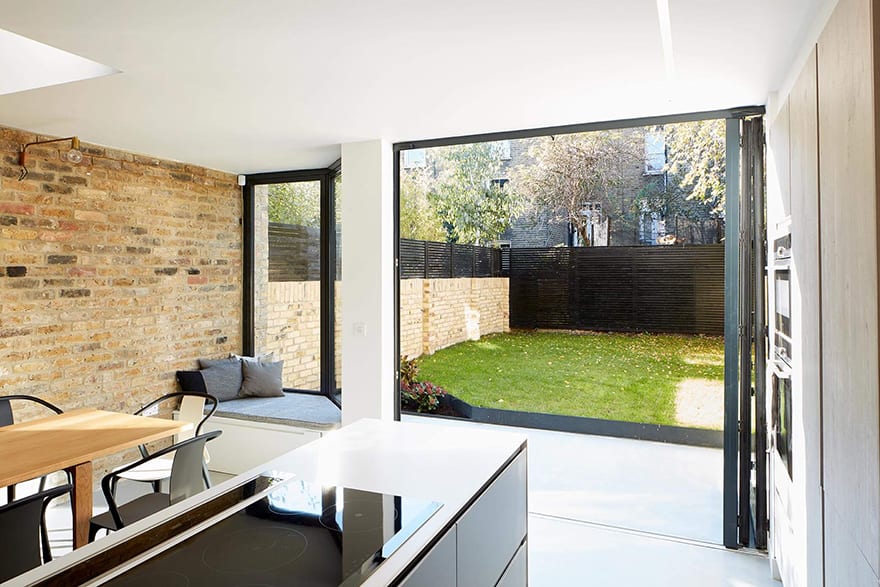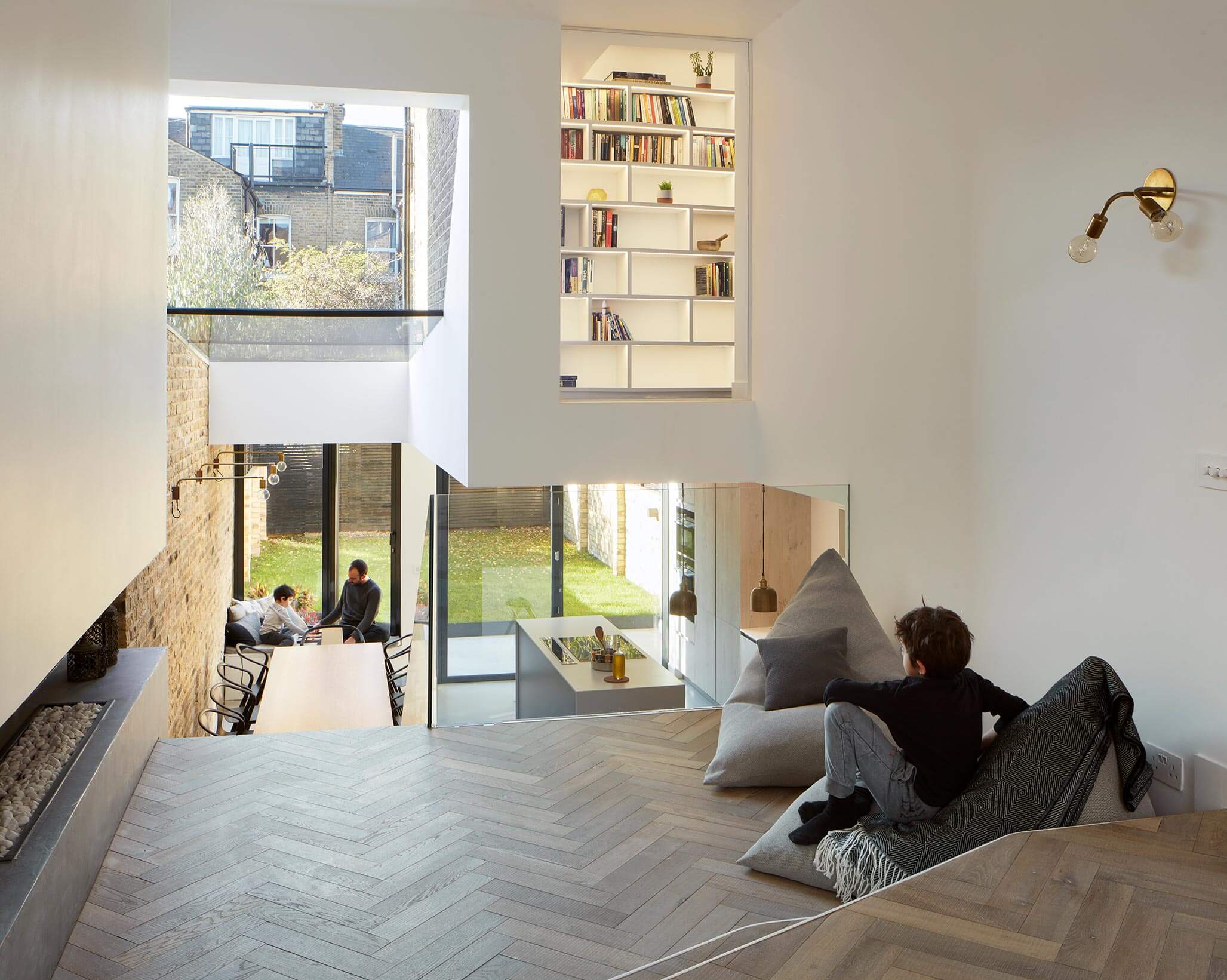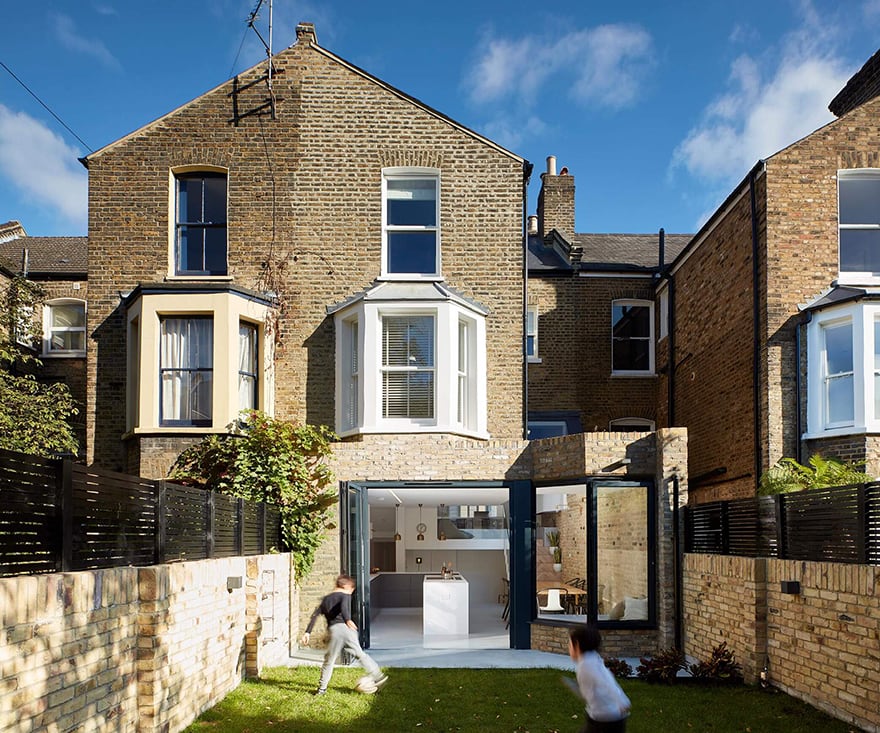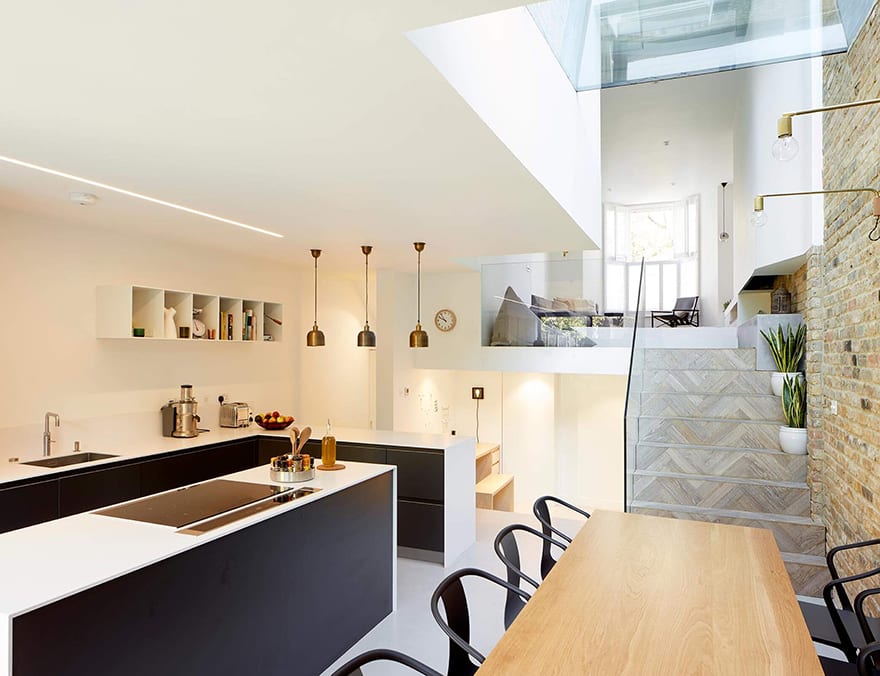- Client: Private homeowners
- Lead Contractor: Scenario Architecture
- BIM Tools: ArchiCAD, BIMx
Ran Ankory and Maya Carni, directors of Scenario Architecture, transformed their dark, Victorian terrace house into a light-filled, open plan home ideal for modern family life.
The architects wanted to connect the front part of their house with the basement below to create an open plan family area including living, dining and kitchen spaces.
The whole house was reconfigured, to open the space up and let daylight into the main living areas. The architects created a split-level double reception, connected to the kitchen and garden via an angled glazed roof light. A “floating” library feature leads up to the bedroom floors.
Ran Ankory takes up the story: “We started by creating an accurate BIM model of the original house in ARCHICAD. We decided to join the two reception rooms by lowering one of the floors, so it feels like one space.
“We used all the available space, under the stairs and eaves as well as other areas with restricted height. One of these spaces, beneath the lowered reception area, presented an opportunity for a fun and practical kids’ area.
“A storage unit under the stairs features a pull-out table and bench, inviting the kids to do homework and art activities in a designated yet connected part of the home. By including our children in the design process their bedroom came to include a ‘secret space’ entered via a climbing wall and exited using a fireman’s pole.”


Images: Matt Clayton
The design meant Ankory and Carni needed to gut the entire house. Only the original external walls remained – they even replaced the roof.
“Inside everything is modern, but outside the project was a restoration,” says Ankory. “We replaced the existing extension and added a new window seat. We restored some of the original Victorian features and used reclaimed bricks to match the existing walls. The house is now structurally sound and is good for another 50-70 years.”
Sharing information with structural engineers
Changing the floor levels inside created a structural challenge and Scenario needed to coordinate carefully with the structural engineers.
Ankory continues: “Having designed a floating living space over the kitchen, we had to exchange detailed information with the structural engineers.
“Our structural engineers use SketchUp but we could easily import and export models from ARCHICAD using IFC format. In situations like this, the most important thing is communication, it doesn’t matter if you’re using different platforms.”
The design included a custom-made glazing system. Due to time constraints on the project, Ankory and Carni wanted to get the glazing manufactured as soon as possible, even before any structural openings were ready to be measured.
Ran says: “With help of the ArchiCAD, we were able to reassure the glazing company that we could take accurate measurements from the BIM model and that they could manufacture from those measurements. If we hadn’t been able to do this, we would have lost considerable time on the project.”
Bringing more light into the property was a critical element of Scenario’s design. The team used ArchiCAD’s sun analysis to show the effect of the sun on the house throughout the day and at different times of year.


The team also used ArchiCAD’s renovation filter, enabling designers, structural engineers and contractors to see the existing building, what would be demolished and what would be built.
Ankory says: “As we changed both the location and the levels of the bathrooms, ArchiCAD’s MEP modeller was invaluable in helping with coordination. This tool is great for doing simple MEP in-house; it’s not to the level that a mechanical engineer would require, but it is great for coordination on a small project like this.”
Graphisoft’s BIMx visualisation tool also played a key role in the Scenario House project, helping to convey the design ideas to the planners and resulting in a much smoother planning process.
“We love the capability that BIMx offers,” Ankory adds. “It enables clients, planners and contractors to view the ArchiCAD model either on tablets or smartphones, or with Google Cardboard for a full VR experience. Our contractors also love BIMx. They can access it on site on their tablets and we always have it open when we go to site meetings.”
The benefits of BIM for small projects
On the notion that BIM is only relevant for large projects, Ankory says: “From our perspective, BIM is invaluable on smaller projects. It ensures you get everything right in terms of coordination and budget, as with tighter budgets there’s no room for manoeuvre. The impact of getting something wrong on a small project is immediately obvious.
“With BIM our approach is to work from a single functional design which we amend and improve over time. The single model approach from start to finish allows us to keep all the data in one place.
“ArchiCAD is an incredibly flexible design tool. It combines 3D modelling with the accuracy of BIM, bringing design, visual and production information into a single platform.”
He adds: “We have a down-to-earth definition of BIM which is about collaborating in 3D. For us, BIM is really to do with collaboration on projects. And we are improving on this all the time.”
35% faster from design to site
Using ArchiCAD and Teamwork project management software, Scenario now solves any issues along the way much faster.
“This set up saves us time and money and helps to remove the unpredictability from a project,” says Ankory. “From design stage to site we’re 30-35% faster using ArchiCAD. Once the project gets onsite the time savings grow exponentially.
“For example, when there’s an issue to solve we can update all 20 drawings in one go. Previously, any issues that came up on site could take weeks to address; they’re solved at least 60% faster now.
He concludes: “Above all, our projects are quality driven. With the help of ArchiCAD, we can deliver a better result for our clients every time. And in the case of Scenario House, as both client and architect, the results speak for themselves.”
Comments
Comments are closed.













Beautiful design/space
The pointing on the back of the gable with the neighbour could have been a lot tidier! Vertically it’s all over the place and trespassers onto the neighbour’s wall which is a shame and looks unfinished. Obviously not a BIM area of the work but visually quite noticeable to say a surveyor or building photographer. If my bricklayers had done that there would have been words! To me it spoils the rear elevation. Kind regards Mick M Architect